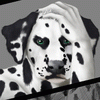
This guy was made from faux fur, wire, sculpty, and felt.
And just for fun:
Ecology:
Artic Owl Bears, as their names imply, live in frigid regions far north of the equator. They do not molt or change color with the seasons, and so must constantly migrate to keep with the cold weather. They live in arboreal forests in winter, and move to artic or mountainous regions once the forests reach their summer seasons. Young owl bears are occasionally found in the forests all year around, as they are too weak and lack the stamina of the adults to travel such great distances.
Those that stay in the forests year around often live off of berries and honey combs, and the small vermin that scuttle through the dense forest underbrush. They have a unique hunting strategy of climbing high in the treetops and pouncing on prey by jumping off their perches to the ground below. Unlike their southern warm climate cousins, Arctic Owl Bears are small in size, barely the size of a large draft horse. This is said to conserve energy and heat. Their thick pelts are dappled with black, which blends perfectly in with snowy mountains and rocks.
Their claws are gigantic, and they use these formidable weapons to fight rival owlbears, defend themselves against predators, and dig open ice or hives to reach their favorite prey. A bony knob sits at the end of their unusually long tails, and is strong enough to shatter iceburgs and tree trunks when used. However, this knob is usually hidden from view by the thick black tufts that surround them.
Arctic Owl Bears are the most docile of their kind. They will usually flee when confronted by humans, and only attack people when injured, or protecting their young. Owl Bears have been domesticated by the local tribes in the area to some success, and serve as hunting animals and guards. Some are kept as pets for the rich, but must be handled with care. If its owner ever strikes it or mistreats it, owl bears become vicious and feral, and can never be kept around people again.
This young owl bear, too young to make the trip north from Alaska's forests, is doing what it does best. Climbing the great trees to avoid predators on the ground, and searching for tasty grubs and honeycomb to eat.
And just for fun:
Ecology:
Artic Owl Bears, as their names imply, live in frigid regions far north of the equator. They do not molt or change color with the seasons, and so must constantly migrate to keep with the cold weather. They live in arboreal forests in winter, and move to artic or mountainous regions once the forests reach their summer seasons. Young owl bears are occasionally found in the forests all year around, as they are too weak and lack the stamina of the adults to travel such great distances.
Those that stay in the forests year around often live off of berries and honey combs, and the small vermin that scuttle through the dense forest underbrush. They have a unique hunting strategy of climbing high in the treetops and pouncing on prey by jumping off their perches to the ground below. Unlike their southern warm climate cousins, Arctic Owl Bears are small in size, barely the size of a large draft horse. This is said to conserve energy and heat. Their thick pelts are dappled with black, which blends perfectly in with snowy mountains and rocks.
Their claws are gigantic, and they use these formidable weapons to fight rival owlbears, defend themselves against predators, and dig open ice or hives to reach their favorite prey. A bony knob sits at the end of their unusually long tails, and is strong enough to shatter iceburgs and tree trunks when used. However, this knob is usually hidden from view by the thick black tufts that surround them.
Arctic Owl Bears are the most docile of their kind. They will usually flee when confronted by humans, and only attack people when injured, or protecting their young. Owl Bears have been domesticated by the local tribes in the area to some success, and serve as hunting animals and guards. Some are kept as pets for the rich, but must be handled with care. If its owner ever strikes it or mistreats it, owl bears become vicious and feral, and can never be kept around people again.
This young owl bear, too young to make the trip north from Alaska's forests, is doing what it does best. Climbing the great trees to avoid predators on the ground, and searching for tasty grubs and honeycomb to eat.
Category Sculpting / Fantasy
Species Mammal (Other)
Size 1024 x 1010px
File Size 543 kB

 FA+
FA+








Comments